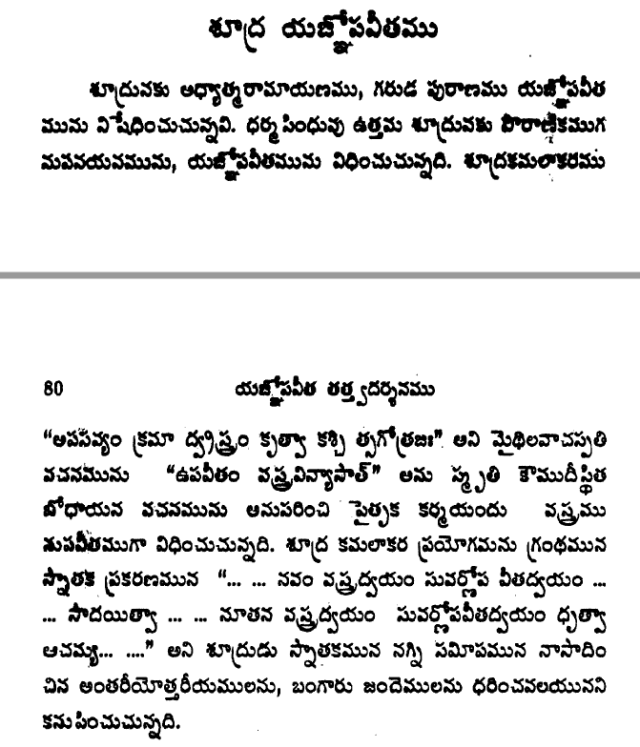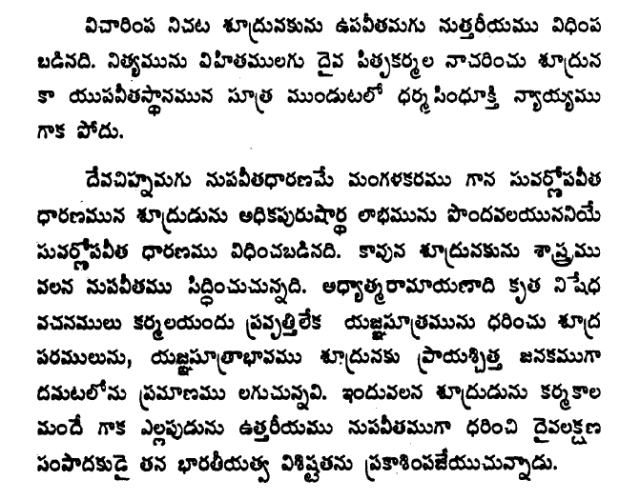yajnOpavItaM is an important symbol in the Hindu culture. It is a symbol of the devata-s and is a very important tool in performing yajna. I used to hear from my elders that yajnOpavItaM is only for brAhmaNa, kshatrIya, and vaishya varNa-s. My inquiries into why led me to various answers from elders. Some of them included straight “shastras prohibit them”.
Still, if the universality of Hindu dharma is true, then the unavailability of a simple tool like yajnOpavItaM in the pursuit of a dharmic life didn’t seem logical. Thanks to the downtime provided by the ongoing corona pandemic, there was time to spare in reading books. Tirumala Tirupati Devasthanam’s online ebook site is a treasure trove of knowledge with a varied variety of books on all the topics related to Hindu culture. On that site, I could find the book “yajnOpavIta tattva darshanamu“. Written by vEdamUrti shrI avvAri rAmamUrti shastri of Vijayawada in 1951, the book was reprinted in 2006 by TTD. This book goes into all the details about yajnOpavItaM with pramANa from the primary sources – shruti, smRti, sUtra, purANa etc., with special focus on Apastamba sUtra (could be because a large number of Telugu Hindu society are Apastambiya – knowingly or unknowingly).
One of the questions I was really looking forward to finding an answer to was the question of yajnOpavItaM for shUdra-s. The book had an answer. Unequivocal. With pramANa and total clarity. shUdra-s have a necessity to wear yajnOpavItaM. The specific section where the vEdamUrti makes these arguments is provided in the following snapshot.
The author answers this assertion with two specific arguments – one based on shUdra kamalAkara, the other a more philosophical argument.
Arguments based on shUdra kamalAkara
This blog had discussed briefly shUdra kamalAkara in the past. This book is one of the most important works that had repositioned the Hindu society in the wake of the Islamic invasions on India. Written by the erudite scholar kamalAkara bhatta, whose nirNaya sindhU became a defacto reference for judges in the British Raj, the book provides a detailed description of the rites that shUdra-s must do including the procedure that must be followed.
The book has been a guiding beacon for the brAhmaNa community in Andhra Pradesh at least. Since the book originated from the lands of the Marathas, it wouldn’t be surprising if it had a profound impact in those regions too. To this day, many brAhmana-s in AP follow the book while performing rites for shUdra-s.
shrI avvAri rAmamUrti shAstri gAru takes pramANa from shUdra kamalAkara which specifies that shUdra-s have to wear a golden yajnOpavItaM during the funeral rites. The author uses this to pivot the issue into a necessity using a further philosophical argument. The author does note that AdhyAtma rAmayaNa and garuDa purANa prohibit the shudra-s from wearing the yajnOpavItaM. But the fact that shUdra kamalAkara insists on a golden yajnOpavItaM means, according to the author, that the yajnOpavItaM during the dharma karya is provided to the shUdra as a necessity to succeed in the rite by propitiating the gods. Therefore, by shAstra, shudra has a necessity to wear yajnOpavItaM for purushArtha siddhi. Since a shAstrOkta mandate overrides a paurANOkta mandate, there is a clear indication that shUdra-s not only have a right but have a necessity to wear yajnOpavItaM just as the other three varnas are required to.
Philosophical argument
The yajnOpavItaM occupies a very important place in a Hindu’s life. Just as with shikhA, yajnOpavItaM too is a symbol of the gods (the author provided pramANa-s in various sections in the book). Presence of yajnOpavItaM elevates the person’s rituals because of the presence of the gods. Philosophically speaking, yajnOpavItaM thus becomes a material tool of pursuit of dharma in a Hindu’s life. To lead a dhArma dhRk life, the person must propitiate the gods and seek their blessings. The only way to please the gods is to perform yajna. To perform yajna, the rites have to be performed as prescribed by various means specified in the Arsha vakya-s as described in the shAstra-s, smRti-s etc. It is from this Arsha vaky-a that we see yajnOpavItaM as a necessary tool in performing yajna.
Therefore, shUdra-s have a necessity to wear yajnOpavItaM in pursuit of dharma dhRk life.
yajnOpavItaM for Women
Hindu society has been derided by the western conservatives, left liberals, communists, neo vendatists etc. for its treatment of shudra-s and women. Therefore, once the question of yajnOpavItaM for shUdra-s is answered, another natural question that comes up is yajnOpavItaM for women.
shrI avvAri rAmamUrti shAstri gAru also answers this aspect. He provides an argument similar to that for shUdra-s – that women have a need to wear a tAtkalika uttarIya in the form of cloth during some of the rites. He also provides pramANa from gObhila gRhya sUtra-s to indicate that the shAstrOkta pramANa is there for women to wear the yajnOpavItaM.
The author also gives us pramANa from the nitya pUjA vidhi where even dEvI is offered uttarIya. He also provides a pramANa from kAvya in the form of kALidAsa‘s kumArasambhava. But the fact that there is a shAstrOkta mandate is enough to say conclusively that even women have a need to wear yajnOpavItaM.
In conclusion
Unfortunately, the modern lifestyle doesn’t appreciate the importance of maintaining a yajnOpavItaM. Even among brAhmaNa-s, there are examples we come across in day to day life of people taking yajnOpavItaM very lightly. Hence, a realignment of shUdra-s and women would be difficult, very much impossible. Even if such a realignment were possible, acceptance of such a realignment from the old guard is even more doubtful. Only if there is a direction from the AcharyA-s of all sampradAya-s with complete consensus across the board, there would be some hope for future generations.
Like with other practices among Hindus, yajnOpavItaM is also fast lost its significance. With lack of faith and understanding, its importance continues to decline. In hopes that the paramAtma is listening to the prArdhanA of a hapless Hindu …!
yajnOpavItaM paramaM pavitraM |
Tailpiece
The upOdghAtamu (preface) of the book is one of the most moving I have read in my studies so far. The author laments the state of the Hindu dharma. He says that despite his difficult physical, mental, and financial situation, it is his duty to write as much as possible to put dharma back in our lives. We are indebted to scholars like brahmashrI vEdamUrti avvAri rAmamUrti shAstri gAru that there is at least this much knowledge and obedience to Hindu dharma left in us. In his summary towards the end, he unequivocally says that “yajnOpavItaM is a symbol of bhAratIyata and hence every bhAratIya must wear it proudly”. Today we find it difficult to think of as bhAratIya-s. Are we bhAratIya-s, truth be told.



Really I had searched for this answer from past 20 years, but no one provided the proper citing and references, but now I see this in web Thanks a lot for lord who shed light to us, through you…. very few will share such information to us… Many God bless you’ll 🙏